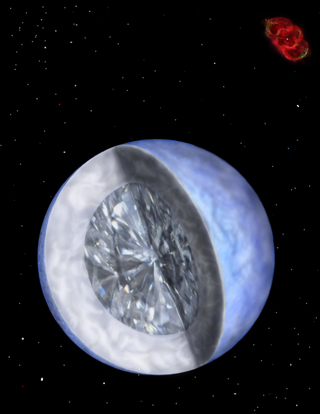Feb 16 2004
 When choosing a Valentine's Day gift for a wife or girlfriend, you can't go
wrong with diamonds. If you really want to impress your favorite lady this Valentine's
Day, get her the galaxy's largest diamond. But you'd better carry a deep wallet,
because this 10 billion trillion trillion carat monster has a cost that's literally
astronomical!
When choosing a Valentine's Day gift for a wife or girlfriend, you can't go
wrong with diamonds. If you really want to impress your favorite lady this Valentine's
Day, get her the galaxy's largest diamond. But you'd better carry a deep wallet,
because this 10 billion trillion trillion carat monster has a cost that's literally
astronomical!
"You would need a jeweler's loupe the size of the Sun to grade this
diamond!" says astronomer Travis Metcalfe (Harvard-Smithsonian
Center for Astrophysics), who leads a team of researchers that discovered
the giant gem. "Bill Gates and Donald Trump together couldn't begin
to afford it."
When asked to estimate the value of the cosmic jewel, Ronald Winston, CEO of
Harry Winston Inc., indicated that such a large diamond probably would depress
the value of the market, stating, "Who knows? It may be a self-deflating
prophecy because there is so much of it." He added, "It is
definitely too big to wear!"
The newly discovered cosmic diamond is a chunk of crystallized carbon 50 light-years
from the Earth in the constellation Centaurus. (A light-year is the distance
light travels in a year, or about 6 trillion miles.) It is 2,500 miles across
and weighs 5 million trillion trillion pounds, which translates to approximately
10 billion trillion trillion carats, or a one followed by 34 zeros.
"It's the mother of all diamonds!" says Metcalfe. "Some
people refer to it as 'Lucy' in a tribute to the Beatles song 'Lucy In The Sky
With Diamonds.'"
The diamond star completely outclasses the largest diamond on Earth, the 530-carat
Star of Africa which resides in the Crown Jewels of England. The Star of Africa
was cut from the largest diamond ever found on Earth, a 3,100-carat gem.
The huge cosmic gem (technically known as BPM 37093) is actually a crystallized
white dwarf. A white dwarf is the hot core of a star, left over after the star
uses up its nuclear fuel and dies. It is made mostly of carbon and is coated
by a thin layer of hydrogen and helium gases.
For more than four decades, astronomers have thought that the interiors of
white dwarfs crystallized, but obtaining direct evidence became possible only
recently.
"The hunt for the crystal core of this white dwarf has been like the
search for the Lost Dutchman's Mine. It was thought to exist for decades, but
only now has it been located," says co-author Michael Montgomery (University
of Cambridge).
The white dwarf studied by Metcalfe, Montgomery, and Antonio Kanaan (UFSC Brazil),
is not only radiant but also harmonious. It rings like a gigantic gong, undergoing
constant pulsations.
"By measuring those pulsations, we were able to study the hidden interior
of the white dwarf, just like seismograph measurements of earthquakes allow
geologists to study the interior of the Earth. We figured out that the carbon
interior of this white dwarf has solidified to form the galaxy's largest diamond,"
says Metcalfe.
Our Sun will become a white dwarf when it dies 5 billion years from now. Some
two billion years after that, the Sun's ember core will crystallize as well,
leaving a giant diamond in the center of our solar system.
For more information on Diamonds